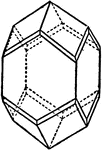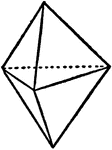Clipart tagged: ‘bipyramid’

Combination of a bipyramid and prism
"...a combination of a bipyramid of the first order with a ditetragonal bipyramid and the prism of the…

Dihexagonal Bipyramid
"...bounded by twenty-four scalene triangles...This form may be considered as a combination of two scalenohedra,…

Ditetragonal Bipyramid
"This is the general form; it is bounded by sixteen scalene triangles, and all the indices are unequal."…

Hexagonal Bipyramid
"...bounded by twelve isosceles trianes each of which are equally inclined to two planes of symmetry."…

Orthorhombic Bipyramids
"This is the general form and is bounded by eight scalene triangles." -The Encyclopedia Britannica 1910

Orthorhombic Bipyramids
"This is the general form and is bounded by eight scalene triangles." -The Encyclopedia Britannica 1910

Trigonal Bipyramid
"...bounded by six isosceles triangles...indices as in the hexagonal bipyramid." -The Encyclopedia Britannica…